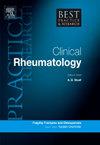Advances in imaging techniques for Sjogren's disease
IF 4.8
2区 医学
Q1 RHEUMATOLOGY
Best Practice & Research in Clinical Rheumatology
Pub Date : 2025-09-01
DOI:10.1016/j.berh.2025.102087
引用次数: 0
Abstract
Imaging of salivary glands (SG), particularly Salivary Glands Ultrasonography (SGUS) is increasingly used in patients with suspected Sjogren's disease (SD). SGUS is the first-line imaging modality. Numerous studies have highlighted this non-invasive, non-irradiating, and low-cost imaging modality. The OMERACT group has established a classification of SG structural damage based on B-mode findings, ranging from grade 0 (normal) to 3 (severe structural damage). SGUS abnormalities (≥ grade 2) have been reported in approximately 63 % of patients with SD. More recently, Hocevar et al. described a Doppler-based classification assessing SG parenchymal vascularization, graded from 0 (normal) to 3 (Doppler signals occupying the entire glandular surface) and could be used as a marker of disease activity and as a biomarker of response to therapy. Moreover, SGUS can be useful for looking for complications such as lymphoma. New ultrasound techniques are currently being developed, including elastography for assessing tissue stiffness, analysis of microvascularization using contrast-enhanced ultrasound with microbubbles, and analysis of minor salivary glands using the ultra-high frequency probe. The combination of several US modalities enhances both sensitivity and specificity of the technique, allowing for the development of a comprehensive multimodal imaging approach. Other imaging techniques can be performed for SD, such as MRI of the parotid glands, allowing analysis of the glandular parenchyma (“salt and pepper” appearance), and certain sequences (DWI-MR) should be performed when lymphoma or other tumors are suspected. 18-FDG PET-CT may be useful to detect systemic manifestations or complications in SD and new PET tracers are currently being developed.
干燥病的影像技术进展。
唾液腺(SG)影像学检查,特别是唾液腺超声检查(SGUS)越来越多地用于疑似干燥病(SD)的患者。SGUS是一线成像方式。许多研究都强调了这种非侵入性、非辐照性和低成本的成像方式。OMERACT小组根据b模式的发现建立了SG结构损伤的分类,从0级(正常)到3级(严重结构损伤)。大约63%的SD患者报告了SGUS异常(≥2级)。最近,Hocevar等人描述了一种基于多普勒的分级,评估SG实质血管化,从0(正常)到3(多普勒信号占据整个腺体表面),可以用作疾病活度的标记和治疗反应的生物标记。此外,SGUS可用于寻找淋巴瘤等并发症。目前正在开发新的超声技术,包括用于评估组织刚度的弹性成像,使用微泡对比增强超声分析微血管化,以及使用超高频探头分析小唾液腺。几种US模式的结合增强了该技术的敏感性和特异性,从而允许开发一种全面的多模式成像方法。其他成像技术可用于SD,如腮腺的MRI,允许分析腺实质(“盐和胡椒”外观),当怀疑淋巴瘤或其他肿瘤时应进行某些序列(DWI-MR)。18-FDG PET- ct可用于检测SD的全身表现或并发症,目前正在开发新的PET示踪剂。
本文章由计算机程序翻译,如有差异,请以英文原文为准。
求助全文
约1分钟内获得全文
求助全文
来源期刊
CiteScore
9.40
自引率
0.00%
发文量
43
审稿时长
27 days
期刊介绍:
Evidence-based updates of best clinical practice across the spectrum of musculoskeletal conditions.
Best Practice & Research: Clinical Rheumatology keeps the clinician or trainee informed of the latest developments and current recommended practice in the rapidly advancing fields of musculoskeletal conditions and science.
The series provides a continuous update of current clinical practice. It is a topical serial publication that covers the spectrum of musculoskeletal conditions in a 4-year cycle. Each topic-based issue contains around 200 pages of practical, evidence-based review articles, which integrate the results from the latest original research with current clinical practice and thinking to provide a continuous update.
Each issue follows a problem-orientated approach that focuses on the key questions to be addressed, clearly defining what is known and not known. The review articles seek to address the clinical issues of diagnosis, treatment and patient management. Management is described in practical terms so that it can be applied to the individual patient. The serial is aimed at the physician in both practice and training.

 求助内容:
求助内容: 应助结果提醒方式:
应助结果提醒方式:


